Phylum Mollusca (Class Gastropoda and Bivalvia) Flashcards
0.0(0)
0.0(0)
Card Sorting
1/100
Study Analytics
Name | Mastery | Learn | Test | Matching | Spaced |
|---|
No study sessions yet.
101 Terms
1
New cards
What does HAM stand for?
Hypothetical Ancestral Mollusc
2
New cards
Describe HAM
A hypothetical primitive ancestor that appear among most members of the mollusca
3
New cards
Describe the foot
A broad, flat muscular organ that is adapted for locomotion and attachment
4
New cards
Describe the visceral mass
Contains the internal organs
5
New cards
Describe the mantle
A fold of tissue that drapes over the visceral mass; space between the mantle and the visceral mass is called the mantle cavity
6
New cards
What is responsible for secreting the shell?
The mantle is responsible for secreting the shell
7
New cards
List the three layers of the shell in order
Periostracum, prismatic layer, and the nacreous layer
8
New cards
What is another name for the nacreous layer?
Mother-of-pearl layer
9
New cards
What are the gills of HAM often indicated as?
One or more pairs of bipectinate gills
10
New cards
What is the specialized rasping (scraping) organ of a mollusc?
The radula
11
New cards
What organ does the radula sit upon?
The odontophore
12
New cards
How is food brought into the mouth of HAM?
They are brought into the mouth because they are bound to mucous secreted by the salivary glands
13
New cards
Is the circulator system in HAM open or closed?
HAM has an open circulatory system
14
New cards
Describe the metanephridia
The excretory organs of HAM
15
New cards
Describe the nephrostome
The funnel in HAM that leads into the exit, the nephridiophore
16
New cards
Describe the nephridiophore
Where waste leaves the body in HAM
17
New cards
Describe the trocophore larvae
The free-swimming ciliated larvae in most molluscs
18
New cards
Describe the veliger
The second larval stage in some molluscs (gastropods)
19
New cards
What is the spat stage?
A stage in some molluscs where they attach themselves to a surface
20
New cards
Name the three evolutionary innovations occurred among gastropods
Changes in the shell, increased development of the head (cephalization), and the embryonic process of torsion
21
New cards
What form of symmetry do gastropods exhibit
Asymmetry
22
New cards
Describe the operculum
A hardened plate on the back of the foot of a gastropod that closes the aperture when the body is withdrawn
23
New cards
What is the typical diet for most gastropods?
They are typically herbivores, but some are specialized to be carnivores
24
New cards
How do aquatic gastropods breathe?
They use gills for respiration
25
New cards
How do terrestrial gastropods breathe?
They obtain oxygen via a well vascularized mantle
26
New cards
What are some subclasses of gastropods?
Prosobranchia, opisthobranchia, pulmonata
27
New cards
What are some examples of Class Bivalvia?
Mussels, clams, scallops, oysters, and shipworms
28
New cards
Does Class Bivalvia possess cephalization?
They possess very little to no cephalization
29
New cards
Does Class Bivalvia possess radula?
They do not possess a radula
30
New cards
Is Class Bivalvia aquatic (fresh water) or marine (salt water)?
They are both (species are found in both fresh and salt water)
31
New cards
How does Class Bivalvia feed?
They use the cilia on their gills to filter feed
32
New cards
Is Class Bivalvia sessile or motile?
They are generally sessile for filter feeding
33
New cards
What is another term for valve?
Shell
34
New cards
Why are they called bivalves?
They have two valves (shells) connected by a hinge ligament
35
New cards
How are the two valves held together?
They are held together by a hinge ligament
36
New cards
How are the two valves in Class Bivalvia drawn together?
They are drawn together by adductor muscles
37
New cards
What is the oldest part of Class Bivalvia's shell?
The umbo is the oldest part of the shell
38
New cards
Describe the pedal gap
A specific part of a shell of Bivalves that allows for burrowing with the foot
39
New cards
Describe the siphons
Long tubular extensions of the mantle with both inhalant and exhalent openings
40
New cards
Certain molluscs do not possess a foot, but attach themself to a surface. How do they do this?
They fuse or cement one of their shells to the surface
41
New cards
How do most bivalves move?
They extend their foot out between the valves and use it to pull themselves forward
42
New cards
How do scallops move?
They swim by clapping their valves (shells) together to create propulsion
43
New cards
Are Bivalves monoecious or dioecious?
They are dioecious (male and female reproductive parts in separate individuals)
44
New cards
What larval forms do marine bivalves produce?
They produce free swimming trochophore and veliger larvae
45
New cards
What larval form do freshwater bivalve produce?
They produce larvae called glochidia
46
New cards
Describe glochidia
They are housed in the outer gills of fish and then parasitize the fins and fills of fish when released
47
New cards
What is another name for the foot?
The retractor
48
New cards
Describe the pallial line
The point of attachment of the mantle to the valve
49
New cards
What is another anme for the mantle?
The pallium
50
New cards
What is another name for the pair of gills in bivalves?
Ctenidia (singular: ctenidium)
51
New cards
Where does the food enter in a bivalve?
They enter through the incurrent siphon
52
New cards
Where does waste and gill-cycled water escape?
They leave through the excurrent siphon
53
New cards
Describe the first step of digestion in bivalves
Food enters the incurrent siphon and onto the mouth
54
New cards
Describe the second step of digestion in bivalves
Food goes from the mouth into the esophagus
55
New cards
Describe the third step of digestion in bivalves
Food goes from the esophagus into the stomach where the food is surrounded by glandular digestive glands
56
New cards
Describe the fourth step of digestion in bivalves
Digested particles pass through the ducts into the digestive glands, where they are absorbed
57
New cards
Describe the style sac
It rotates and frees enzymes for mixing with the food particles
58
New cards
Describe the fifth step of digestion in bivalves
More coarse particles go through the intestine (where little absorption occurs)
59
New cards
Describe the sixth step of digestion in bivalves
The residual waste passes through the rectum which opens into the anus and exits out the excurrent siphon
60
New cards
Describe the first step of the excretory system in bivalves
Water and waste from the coelom is filtered by each nephridium
61
New cards
Describe the second step of the excretory system in bivalves
The nephridium leads into the bladders where water and waste is retained and stored
62
New cards
Describe the third step of the excretory system in bivalves
After being stored in the nephridium, waste and water is released into the suprabranchial chambers
63
New cards
Describe the fourth step of the excretory system in bivalves
Dilute urine from the suprabranchial chambers exits out the excurrent siphon
64
New cards
Describe the nephridium
Waste and water are retained and salts are reabsorbed into the body. It also bends 180 degrees to dilate into the bladder.
65
New cards
What are the three pairs of ganglia in Bivalves
Cerebral visceral, and pedal
66
New cards
Describe the cerebral ganglia
They connect to the other ganglia with nerve trunks
67
New cards
Describe the pedal ganglia
They are connected to the cerebral ganglia. They are connected to motor nerves that supply the muscles of the foot.
68
New cards
Describe the visceral ganglia
They give off motor nerves to the posterior retractor and adductor muscles. They have nerve trunks connected to sensory receptors on the fringe of the mantle.
69
New cards
How are gastropod shells built?
They are built as a series of spirals called whorls
70
New cards
What parts does the circulatory system of a Bivalve include?
Auricles, ventricles, veins, and arteries
71
New cards
Describe the function of the auricles
A pair of chambers that receive blood
72
New cards
Describe the function of the ventricle
A muscular pump
73
New cards
Describe the function of the arteries
They distribute blood to the tissues and tissue spaces through the body
74
New cards
Describe the function of the veins
They return blood to the auricles after it is oxygenated in the gills
75
New cards
Is the circulatory system of a bivalve open or closed?
It is open because arteries and veins are not continuous with one another
76
New cards
Describe the first step in the circulatory system of a bivalve
Blood from the ventricle is pumped into an anterior and posterior aorta
77
New cards
Where does the heart reside within a bivalve?
It resides within the pericardial cavity within the visceral mass
78
New cards
Describe the second step in the circulatory system of a bivalve
The anterior aorta conducts blood through its branches to the anterior digestive structures, the muscular foot, and the mantle in the anterior and ventral part of the body. The posterior aorta supplies blood through its branches to the posterior visceral structures as well as the mantle
79
New cards
How is waste carbon dioxide discharged in bivalves?
Waste and carbon dioxide are discharged into sinuses (tissue spaces)
80
New cards
How is food and oxygen absorbed in bivalves?
Food and oxygen is absorbed from the sinuses (tissue spaces)
81
New cards
Describe the third step in the circulatory system of a bivalve
Veins recover blood from the sinuses and either go to the nephridia or the mantle and gills into the auricles. Waste is filtered through the nephridia.
82
New cards
Describe the fourth step in the circulatory system of a bivalve
Veins from the nephridia go to the gills and absorb oxygen in which it returns to the auricle via a vein. Some respiration also takes place in the periphery in the mantle.
83
New cards
What defense mechanism do sea slugs possess?
They have developed complex chemical and biological defenses to ward off their predators
84
New cards
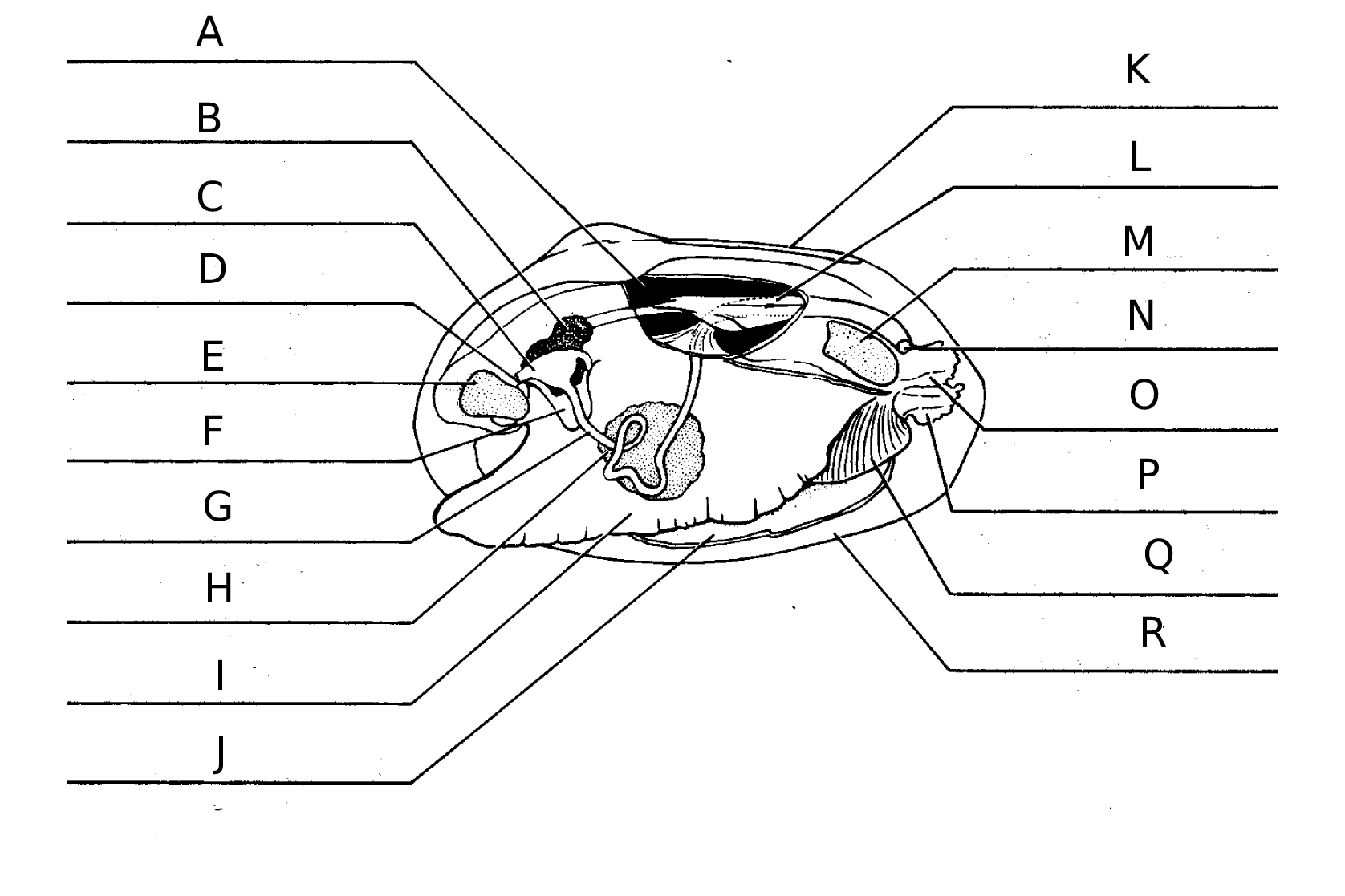
Identify A in the diagram
Pericardial Cavity
85
New cards
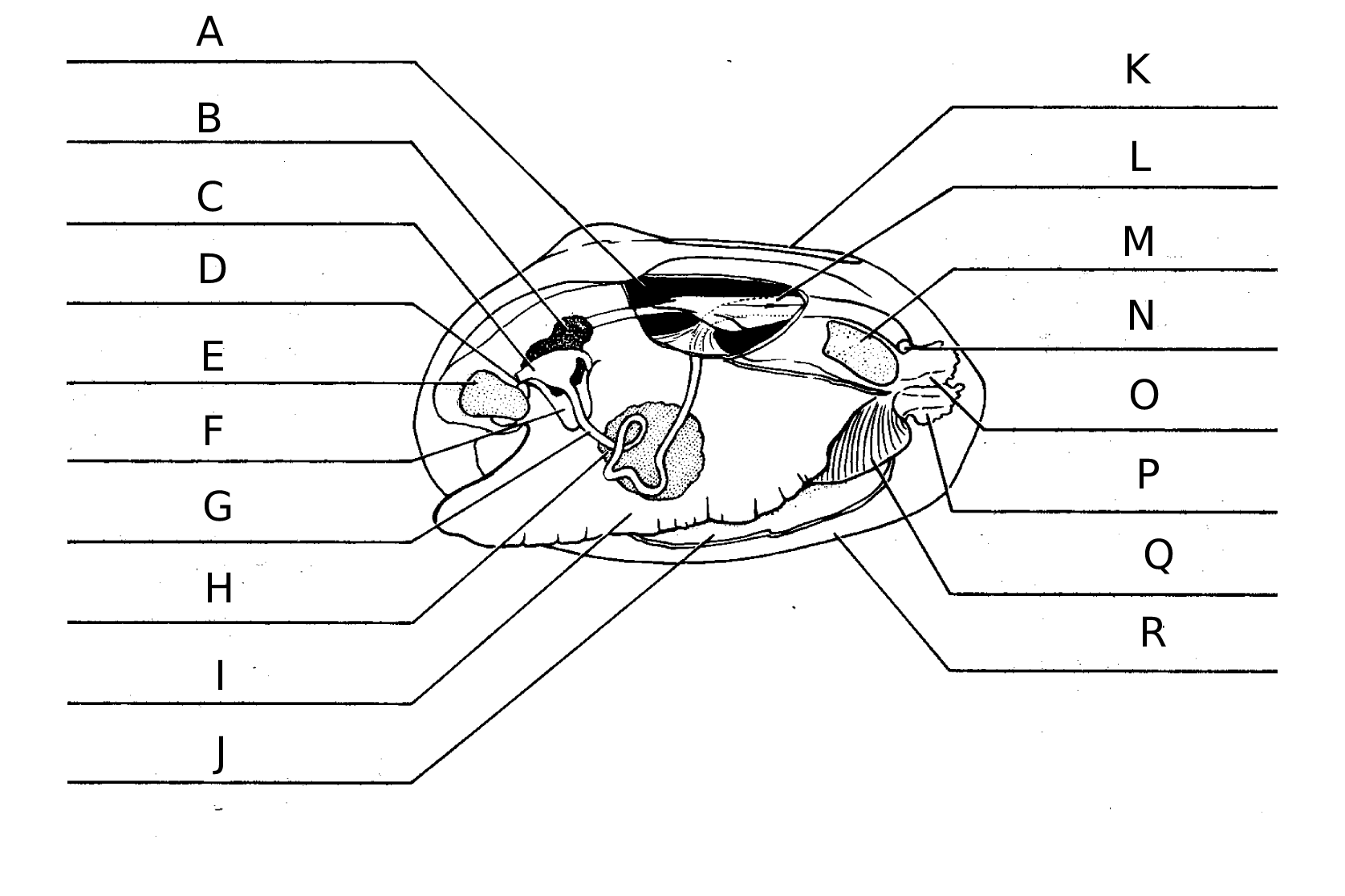
Identify B in the diagram
Digestive Gland
86
New cards
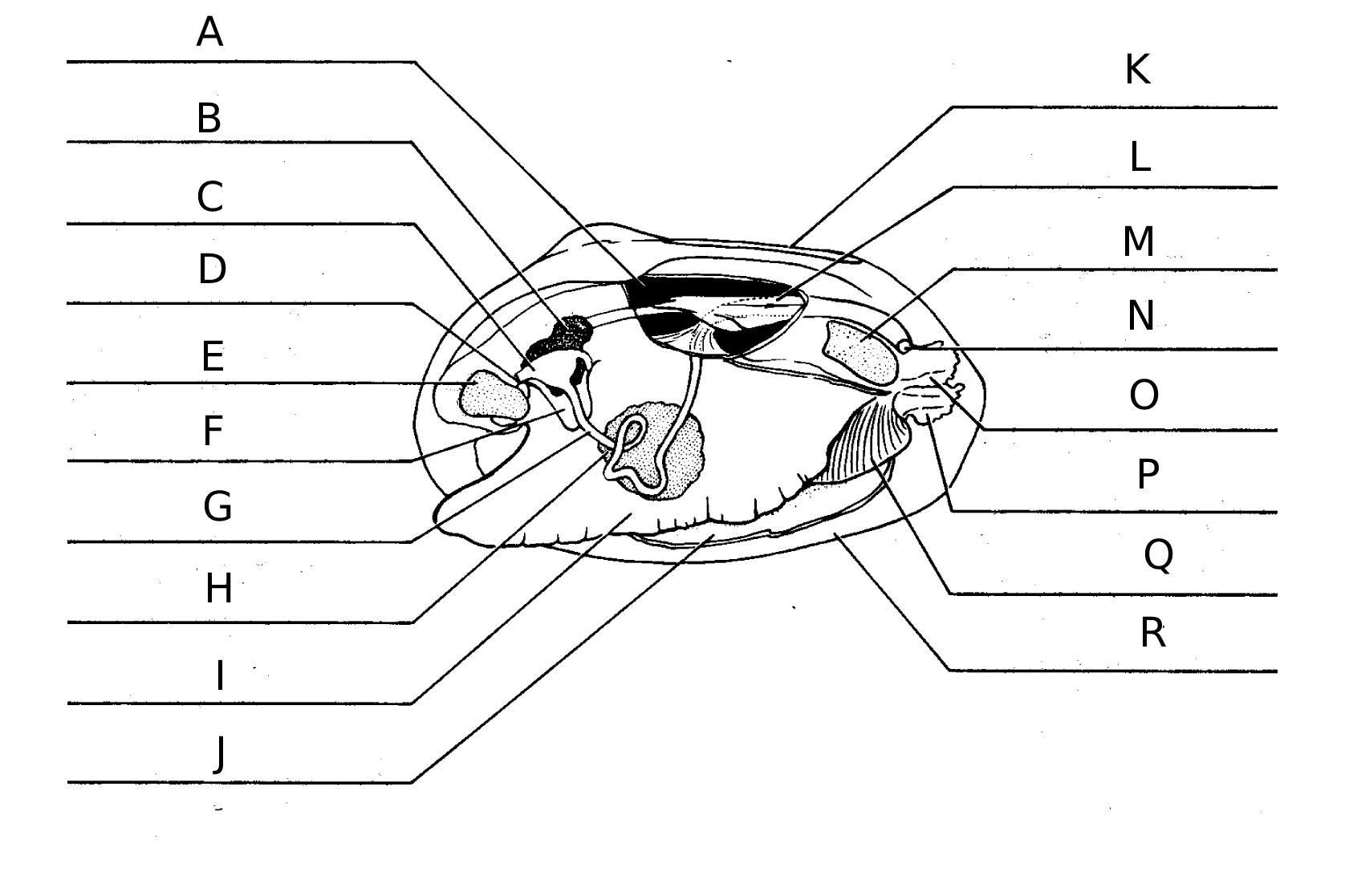
Identify C in the diagram
Stomach
87
New cards
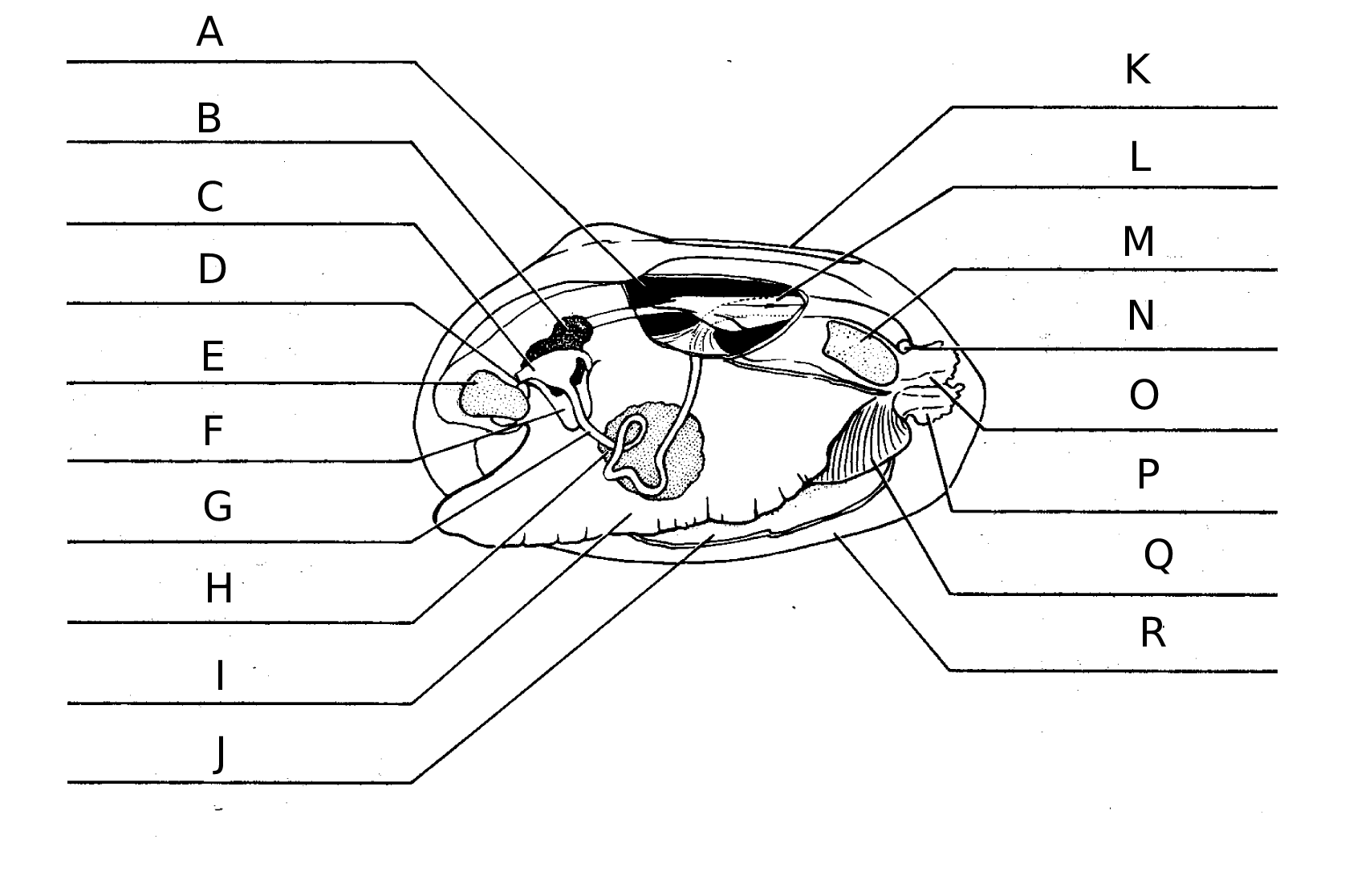
Identify D in the diagram
Mouth
88
New cards

Identify E in the diagram
Ventral (Anterior) Adductor Muscle
89
New cards
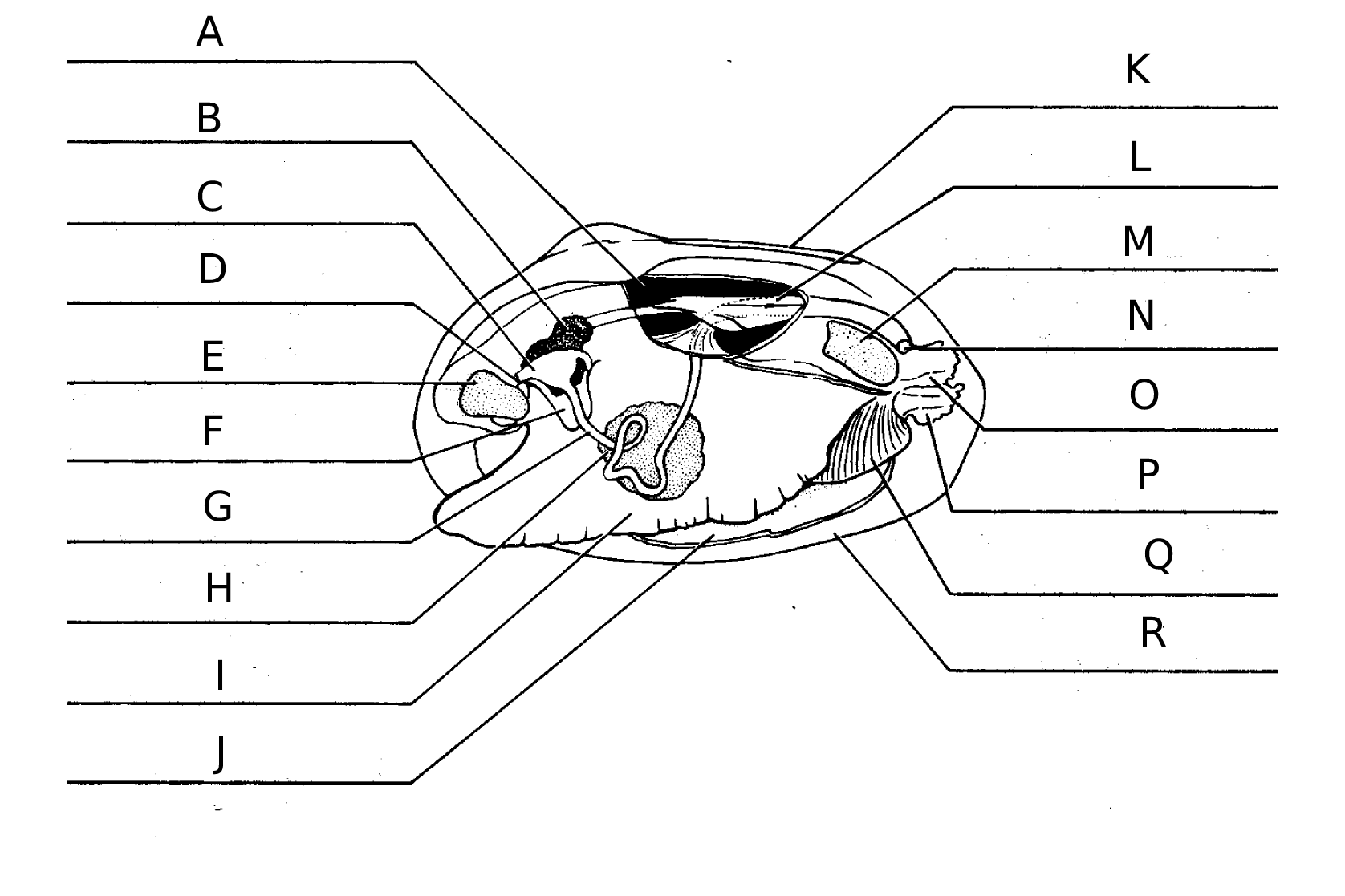
Identify F in the diagram
Labial Palp
90
New cards
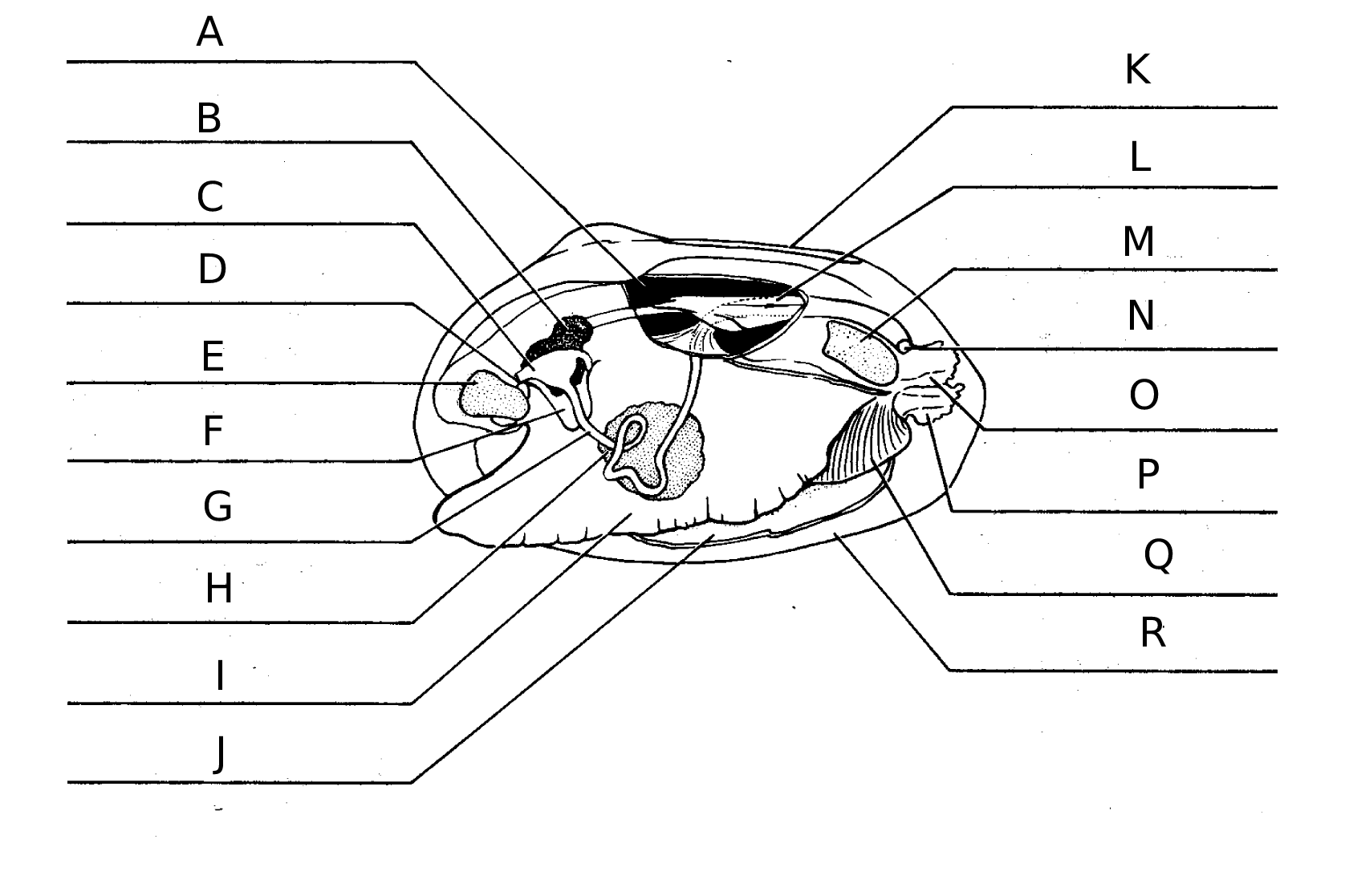
Identify G in the diagram
Intestine
91
New cards
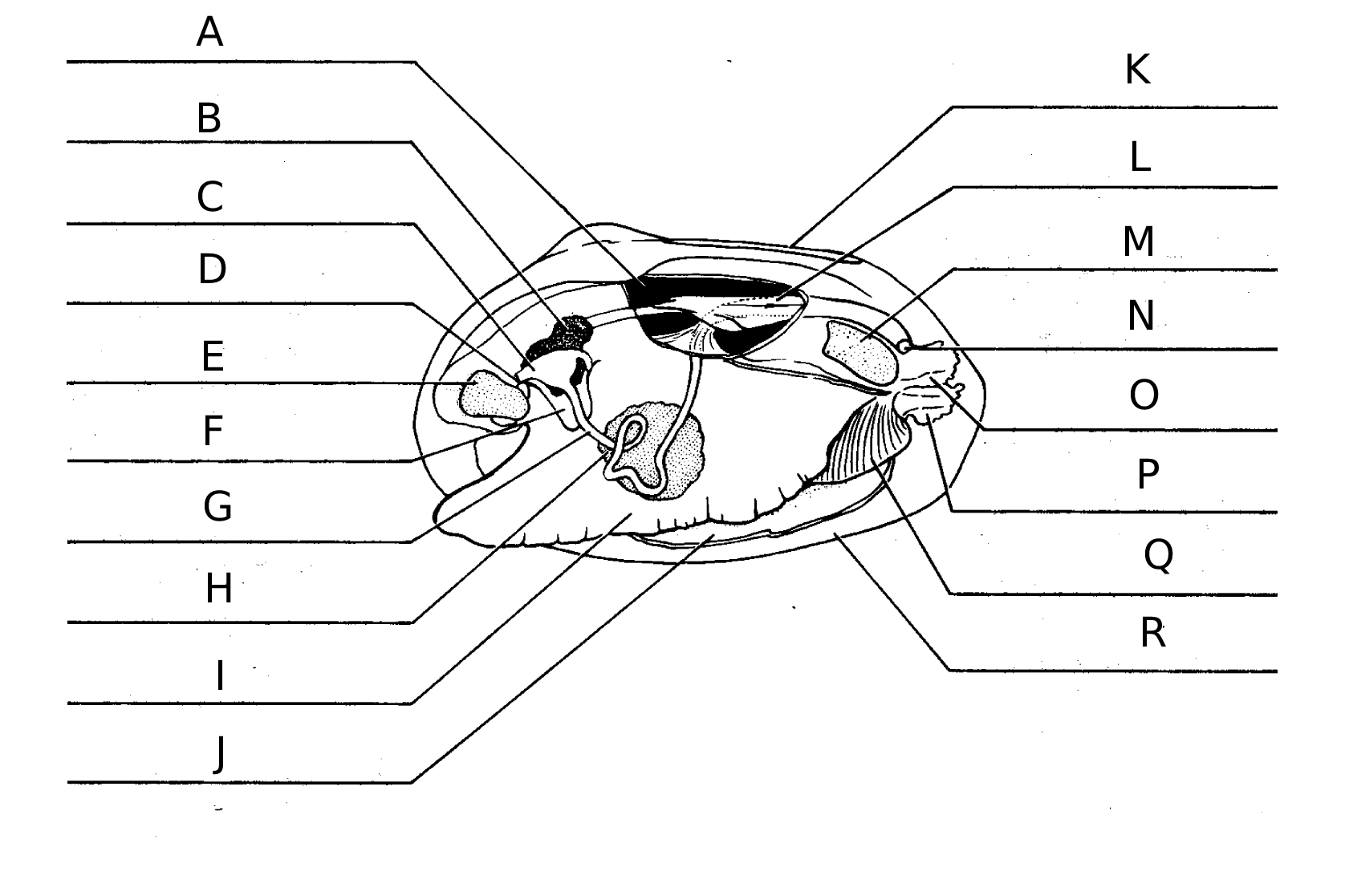
Identify H in the diagram
Gonad
92
New cards
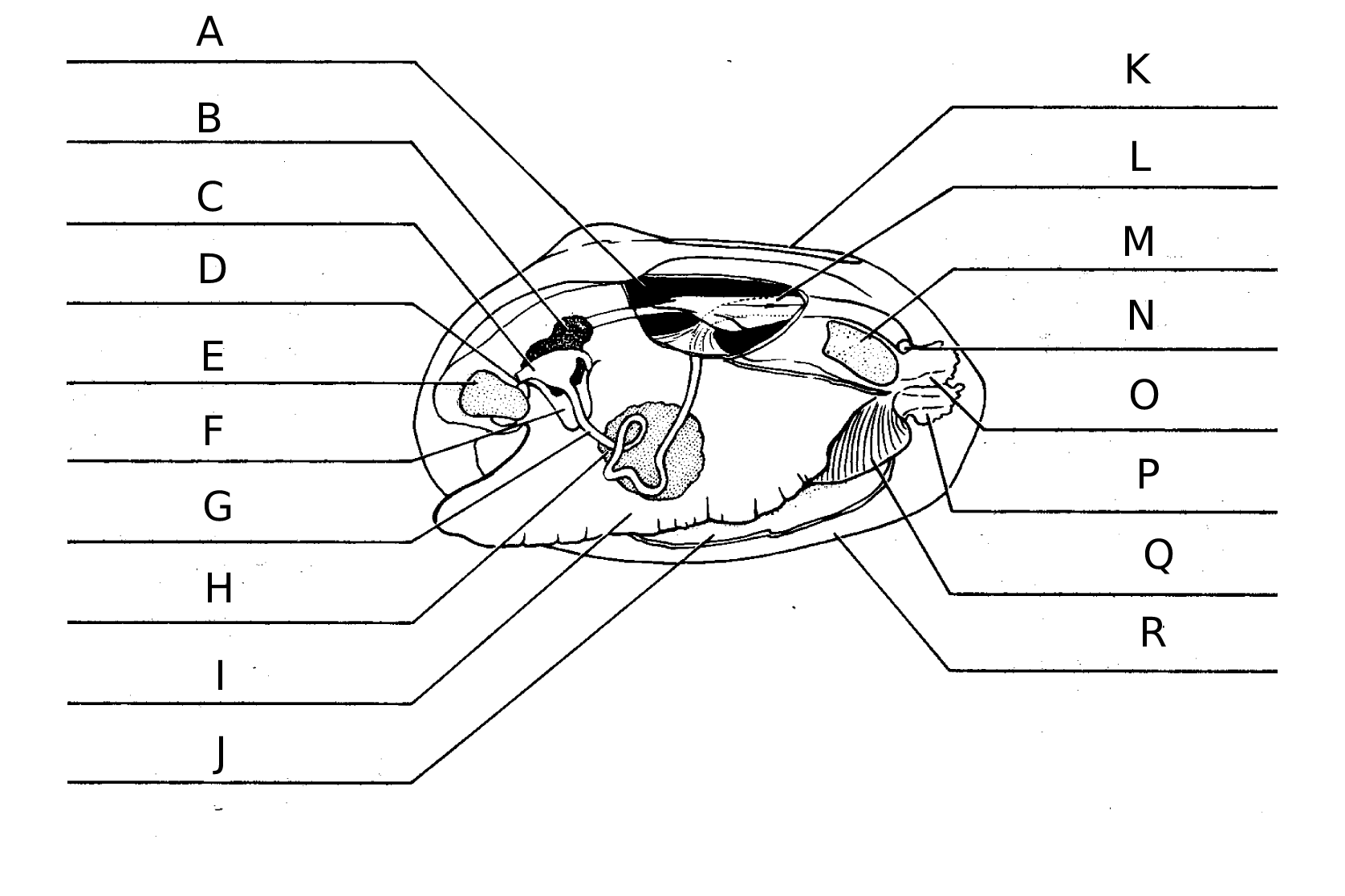
Identify I in the diagram
Foot
93
New cards
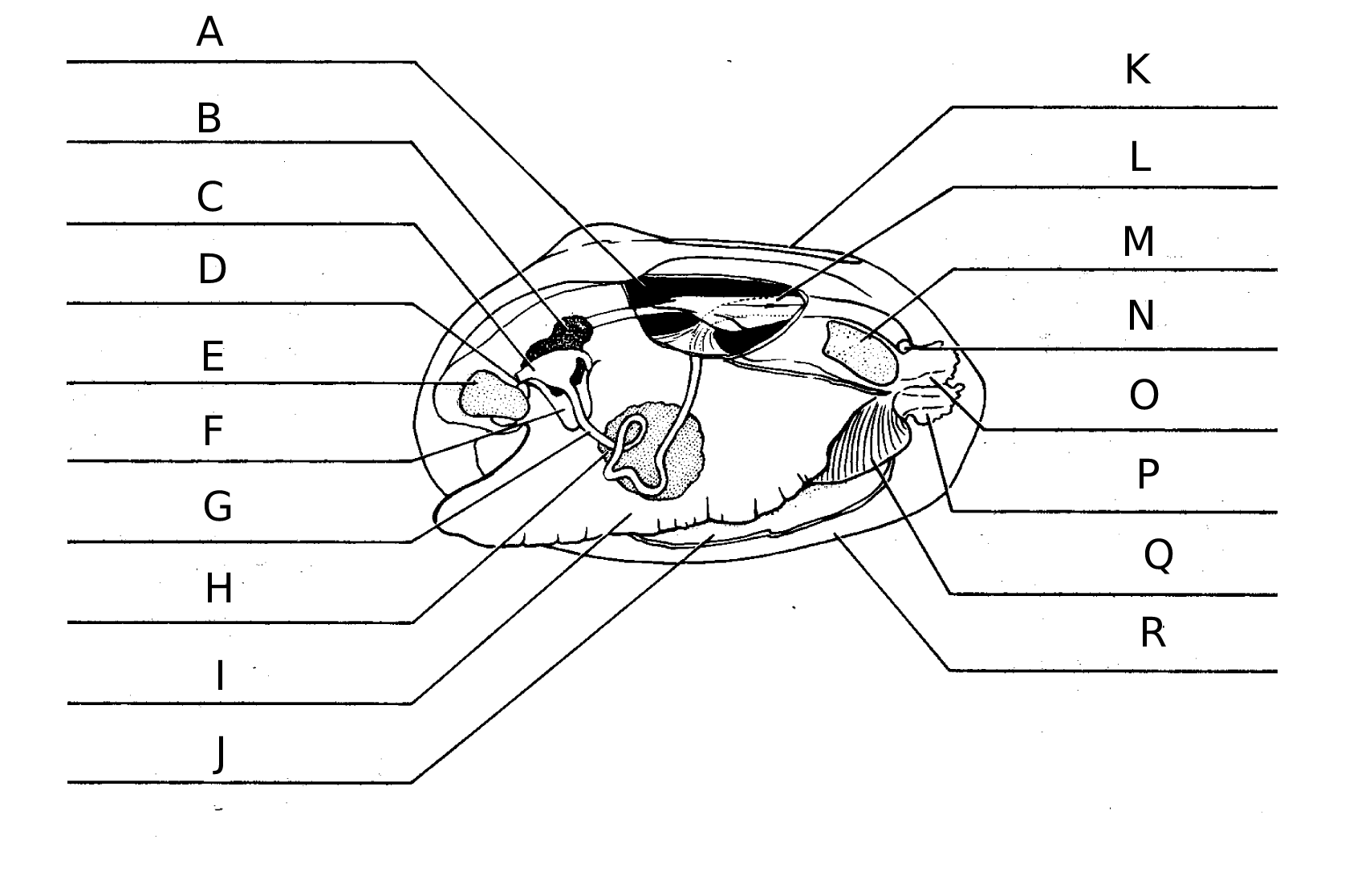
Identify J in the diagram
Mantle
94
New cards
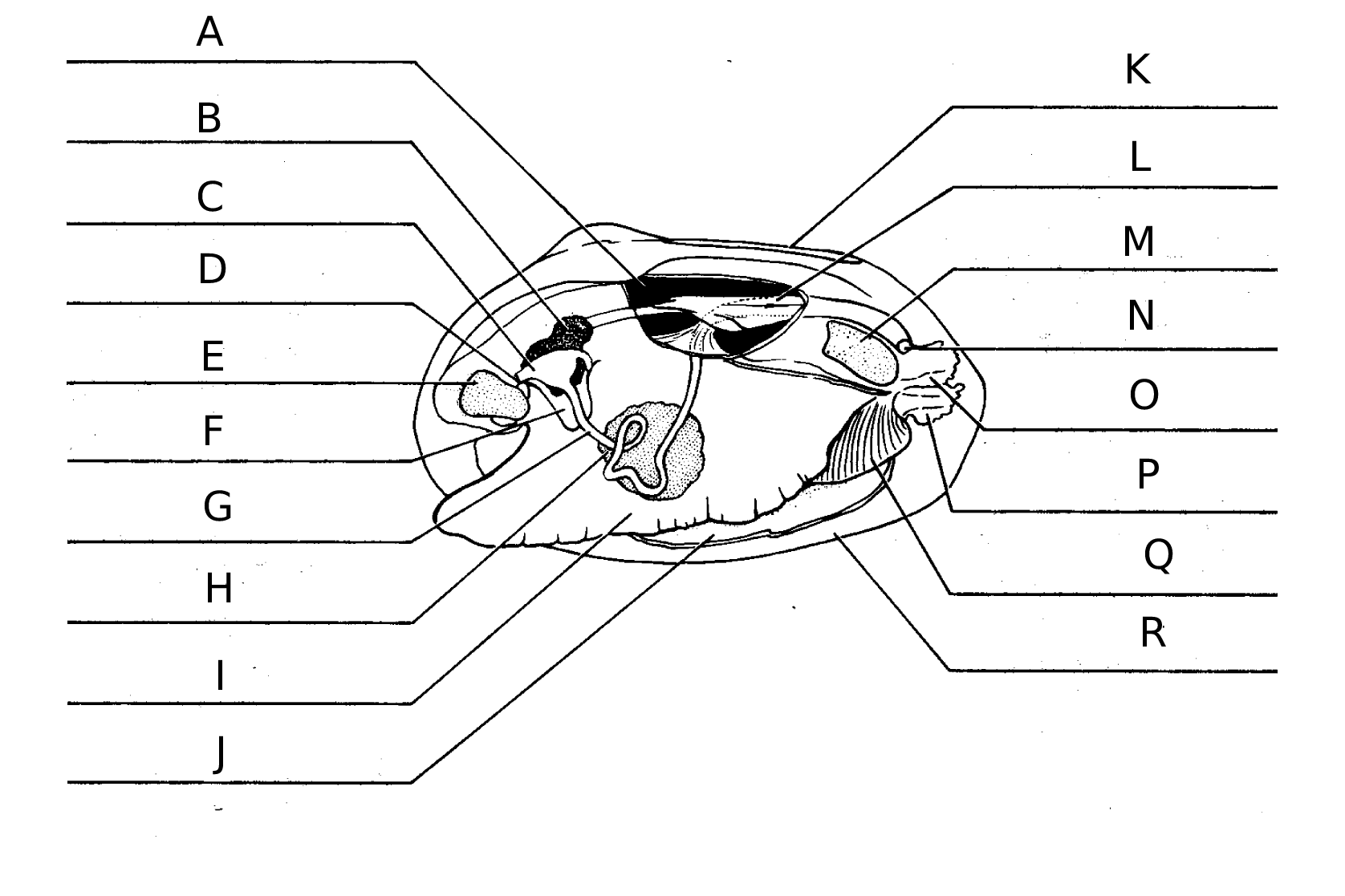
Identify K in the diagram
Periostracum (Outer Layer)
95
New cards
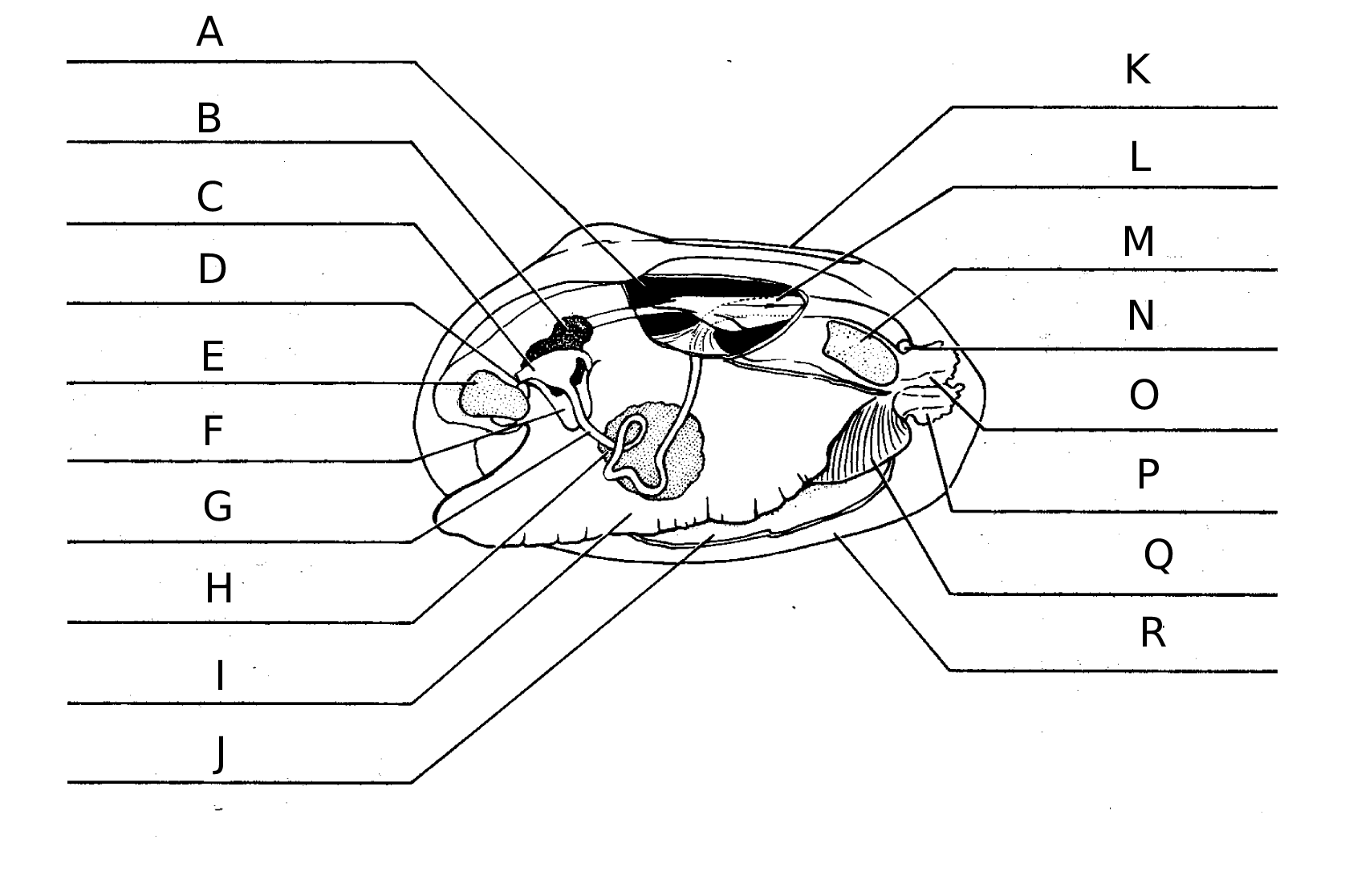
Identify L in the diagram
Auricles and Ventricle (Heart)
96
New cards
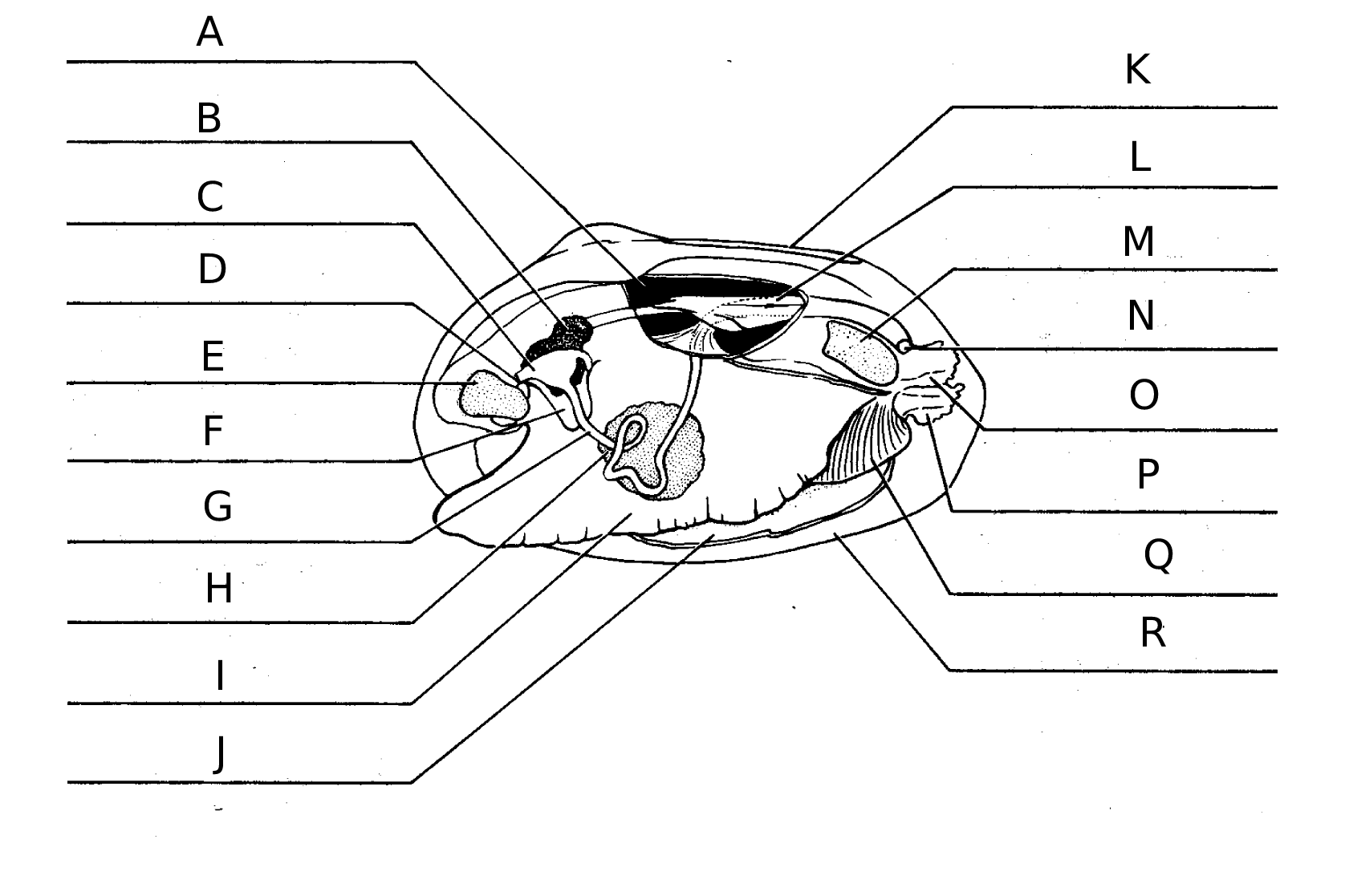
Identify M in the diagram
Dorsal (Posterior) Adductor Muscle
97
New cards

Identify N in the diagram
Anus
98
New cards
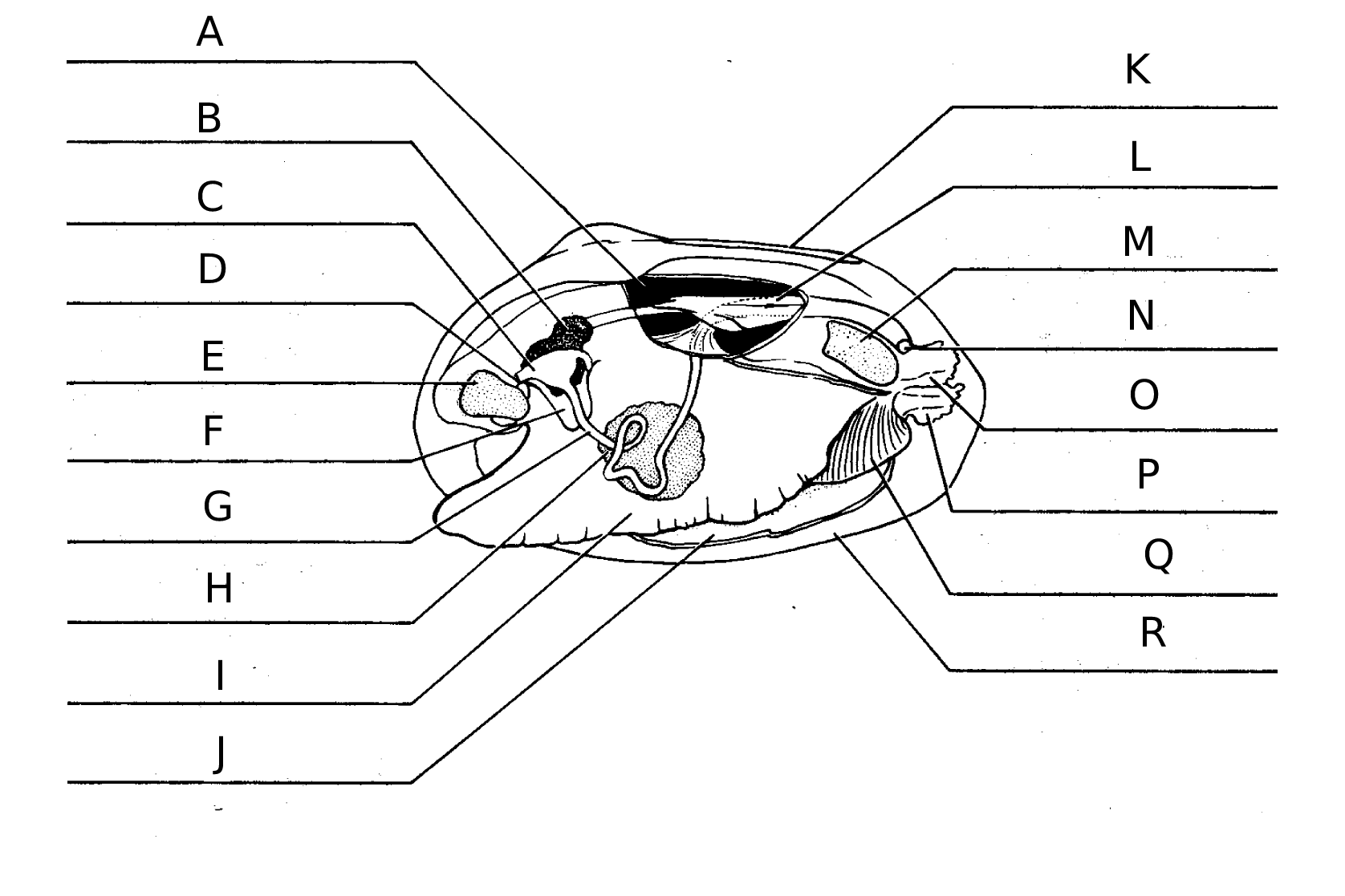
Identify O in the diagram
Excurrent Siphon
99
New cards
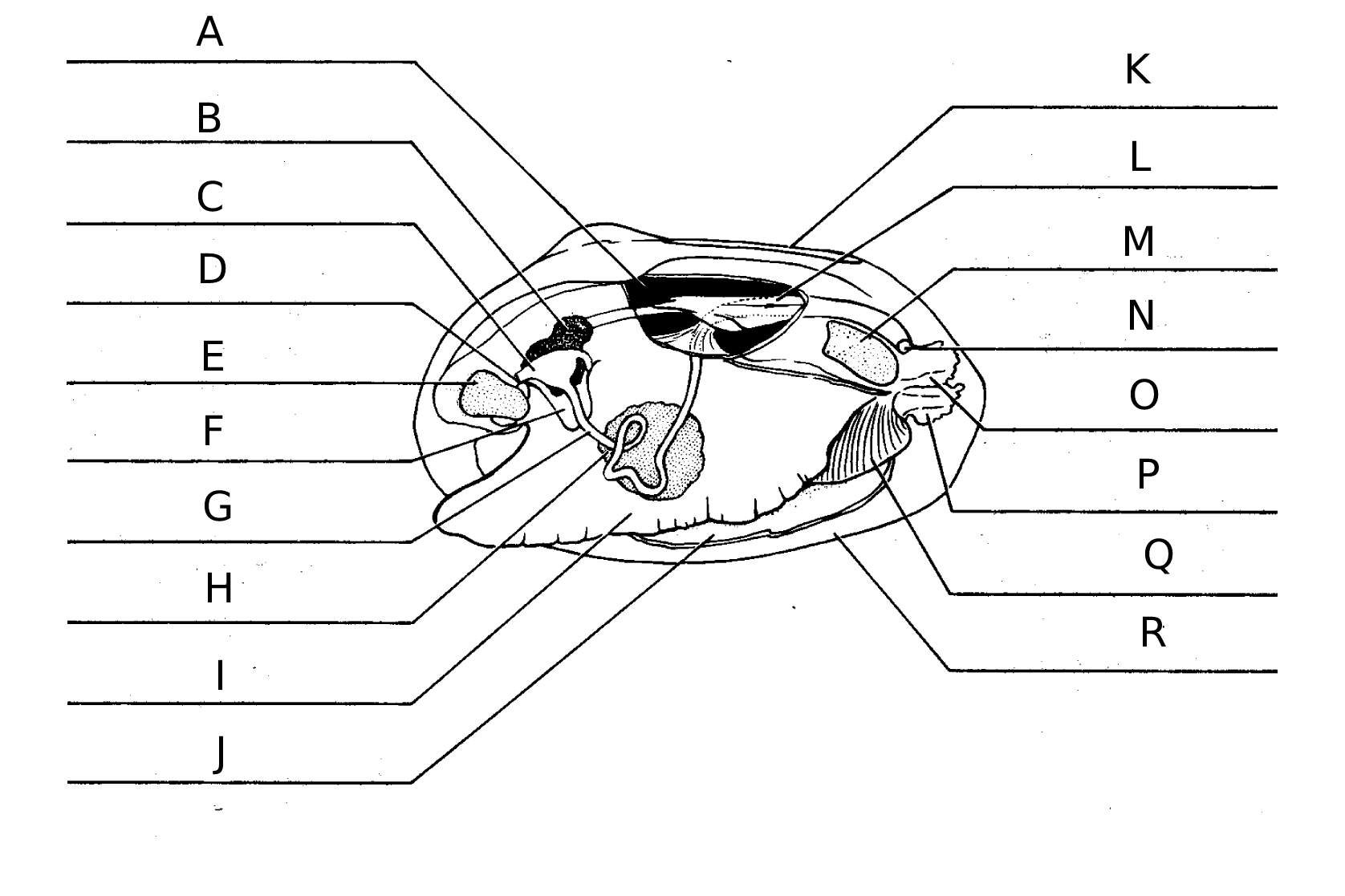
Identify P in the diagram
Incurrent Siphon
100
New cards
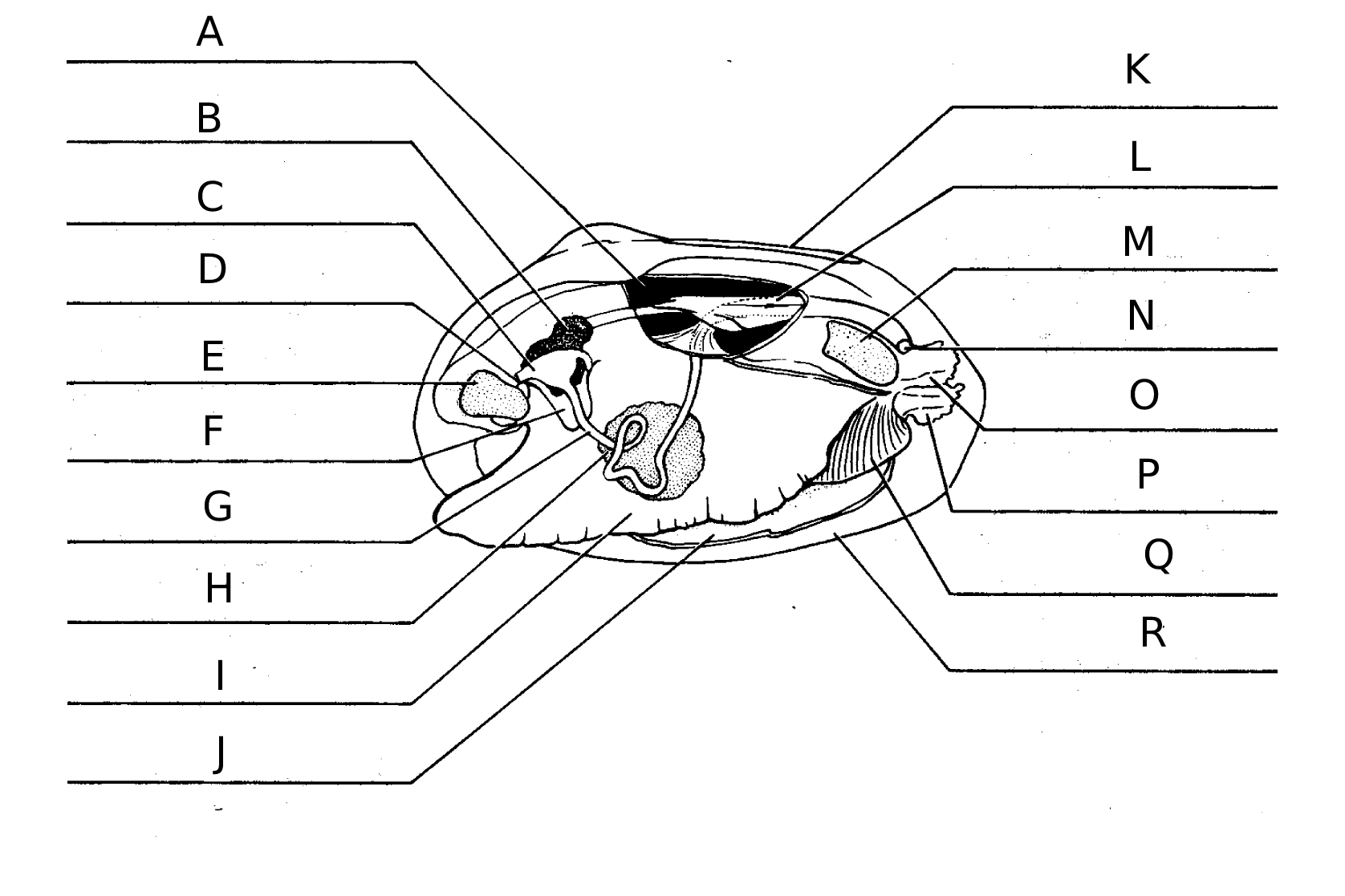
Identify Q in the diagram
Gills